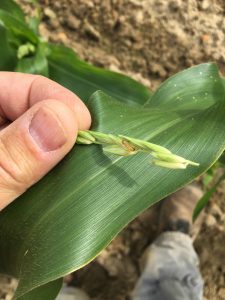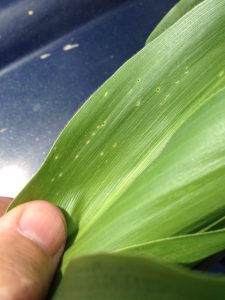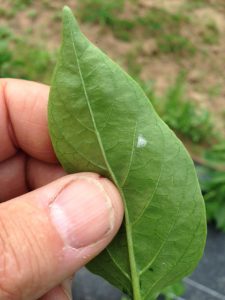Sweet Corn
Warmer evening temperatures have resulted in modest increases in European corn borer (ECB) moth catches in blacklight traps in the northern and central counties. Whorl corn is the primary target for egg laying, and injury over the 12% threshold has been found in Hunterdon County this week. It is likely that there are pockets of feeding throughout the southern counties. Despite relatively low numbers, this pest still poses a threat to plantings now approaching full tassel. It is typical for feeding percentages to rise as the moth catch declines. We expect feeding to increase for the next 1-2 weeks before peaking.
 Look for the characteristic “shot-hole” type of feeding (photo below at right) and consider treating when infested plants exceed 12% in a 50 plant sample. As plantings proceed to the pre-tassel stage, ECB larvae may be found in emerging tassels (see photo at left). It is a good idea to treat individual plantings as they move into the full tassel/first silk stage one time. This eliminates any ECB larvae that have emerged with the tassels as they begin to move down the stalk to re-enter near developing ears.
Look for the characteristic “shot-hole” type of feeding (photo below at right) and consider treating when infested plants exceed 12% in a 50 plant sample. As plantings proceed to the pre-tassel stage, ECB larvae may be found in emerging tassels (see photo at left). It is a good idea to treat individual plantings as they move into the full tassel/first silk stage one time. This eliminates any ECB larvae that have emerged with the tassels as they begin to move down the stalk to re-enter near developing ears.
Useful insecticides for this particular application include synthetic  pyrethroids (IRAC Grp 3), spinosyns (including OMRI approved Entrust) IRAC Grp 5), and diamides such as Coragen or Vantacor (IRAC Grp 28) or materials such as Besiege which include the active ingredient in Coragen. Synthetic pyrethroids alone should NOT be used for corn earworm (CEW) protection on silking corn. Control with these materials is very inconsistent.
pyrethroids (IRAC Grp 3), spinosyns (including OMRI approved Entrust) IRAC Grp 5), and diamides such as Coragen or Vantacor (IRAC Grp 28) or materials such as Besiege which include the active ingredient in Coragen. Synthetic pyrethroids alone should NOT be used for corn earworm (CEW) protection on silking corn. Control with these materials is very inconsistent.
The highest nightly trap catches of ECB for the week ending 6/07/23 are as follows:
| Sergeantsville 2 | Oldwick 1 |
| Asbury 1 | Port Murray 1 |
| Hillsborough 1 | South Branch 1 |
Only a few Corn earworm (CEW) moths have been captured in blacklight traps in the northern and central counties, while an increase in moths captured in pheromone traps occurred over the weekend in those same areas. Extremely limited data from southern New Jersey indicates that there is a low population present there as well. Silking corn is at risk of CEW infestation at this time. Be sure to access information from this publication in the upcoming weeks to determine how frequently you should treat silking sweet corn to protect it from CEW infestation.
The highest nightly pheromone trap catches of CEW for the week ending 6/07/23 are as follows:
| Allamuchy 6 | Beckett 3 |
| Dayton 6 | Chester 1 |
| Califon 4 | Pennington 1 |
| Farmingdale 4 | Sparta 1 |
Silking Spray Schedules*:
South – 4 days
Central – 5 days
North – 5 days
*These recommendations are based on regional catches. Adhere to tighter spray schedules if indicated by local trap catches. Synthetic pyrethroids alone should NOT be used for corn earworm (CEW) protection on silking corn, or for fall armyworm (FAW) management at any stage. Control with these materials is very inconsistent.
Peppers
 With ECB moth activity continuing, growers should be looking for ECB egg masses (see photo at left) on the underside of pepper leaves. The larvae that hatch from these eggs will bore into the central stem of pepper plants in the absence of suitable fruit. This damage causes the tops of the plant to die, and eliminating the crown set of fruit in the process. Check 2 leaves per plant on 5 consecutive plants in 10 random locations. Consider treating if 2 or more leaves are found to have ECB larvae on the lower surface.
With ECB moth activity continuing, growers should be looking for ECB egg masses (see photo at left) on the underside of pepper leaves. The larvae that hatch from these eggs will bore into the central stem of pepper plants in the absence of suitable fruit. This damage causes the tops of the plant to die, and eliminating the crown set of fruit in the process. Check 2 leaves per plant on 5 consecutive plants in 10 random locations. Consider treating if 2 or more leaves are found to have ECB larvae on the lower surface.
Cucurbit Downy Mildew
A cucurbit downy mildew (CDM)sentinel plot has been established at Snyder Farm in Hunterdon County this week. This plot, consisting of pumpkin, watermelon, cantaloupe, butternut, acorn, cucumber and kabocha squash will be used to indicate the presence of cucurbit downy mildew in the region, and what crops are affected. For information on this important disease, and notice of new occurrences, see the Cucurbit Downy Mildew Forecast webpage: http://cdm.ipmpipe.org/. Note that this website has suspended forecasts due to a lack of funding. However, new outbreaks are reported on the interactive map on the homepage. We will report any occurrence on that site, and in this publication. As of this week, no reports of CDM have appeared north of coastal South Carolina.

